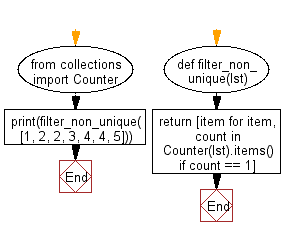Python: Create a list with the non-unique values filtered out
Non-Unique Values in List
Write a Python program to create a list with non-unique values filtered out.
- Use collections.Counter to get the count of each value in the list.
- Use a list comprehension to create a list containing only the unique values.
Sample Solution:
Python Code:
# Import the 'Counter' class from the 'collections' module.
from collections import Counter
# Define a function called 'filter_non_unique' that takes a list 'lst' as an argument.
def filter_non_unique(lst):
# Create a list of items and their corresponding counts using the 'Counter' class.
# Filter this list to include only items with a count of 1.
return [item for item, count in Counter(lst).items() if count == 1]
# Example: Filter out non-unique elements from a list.
print(filter_non_unique([1, 2, 2, 3, 4, 4, 5]))
Sample Output:
[1, 3, 5]
Flowchart:

For more Practice: Solve these Related Problems:
- Write a Python program to extract only the non-unique (duplicate) values from a list while preserving their first occurrence order.
- Write a Python program to filter out non-unique values and return a list that counts how many times each duplicate appears.
- Write a Python program to create a list of elements that occur more than once in the original list, sorted in descending order.
- Write a Python program to remove unique values from a list and output only those elements that are repeated.
Previous: Write a Python program to get the difference between two given lists, after applying the provided function to each list element of both.
Next: Write a Python program to create a list with the unique values filtered out.
Python Code Editor:
What is the difficulty level of this exercise?
Test your Programming skills with w3resource's quiz.
